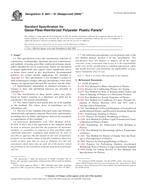Wir benötigen Ihre Einwilligung zur Verwendung der einzelnen Daten, damit Sie unter anderem Informationen zu Ihren Interessen einsehen können. Klicken Sie auf "OK", um Ihre Zustimmung zu erteilen.
ASTM F1921/F1921M-12e1
Standard Test Methods for Hot Seal Strength (Hot Tack) of Thermoplastic Polymers and Blends Comprising the Sealing Surfaces of Flexible Webs (Includes all amendments And changes 2/28/2018).
Automatische name übersetzung:
Standard-Prüfverfahren für Heißsiegelfestigkeit (Hot Tack) aus thermoplastischen Polymeren und Mischungen, die die Dichtflächen Flexible Webs
NORM herausgegeben am 1.7.2012
Informationen über die Norm:
Bezeichnung normen: ASTM F1921/F1921M-12e1
Anmerkung: UNGÜLTIG
Ausgabedatum normen: 1.7.2012
SKU: NS-52091
Zahl der Seiten: 9
Gewicht ca.: 27 g (0.06 Pfund)
Land: Amerikanische technische Norm
Kategorie: Technische Normen ASTM
Kategorie - ähnliche Normen:
Die Annotation des Normtextes ASTM F1921/F1921M-12e1 :
Keywords:
heatseal, heatsealability, hot tack, seal strength, ICS Number Code 83.120 (Reinforced plastics)
Ergänzende Informationen
| Significance and Use | ||||||||||
|
5.1 In form-fill operations, sealed areas of packages are frequently subject to disruptive forces while still hot. If the hot seals have inadequate resistance to these forces, breakage can occur during the packaging process. These test methods measure hot seal strength and can be used to characterize and rank materials in their ability to perform in commercial applications where this quality is critical. 1.1 These two test methods cover laboratory measurement of the strength of heatseals formed between thermoplastic surfaces of flexible webs, immediately after a seal has been made and before it cools to ambient temperature (hot tack strength). 1.2 These test methods are restricted to instrumented hot tack testing, requiring a testing machine that automatically heatseals a specimen and immediately determines strength of the hot seal at a precisely measured time after conclusion of the sealing cycle. An additional prerequisite is that the operator shall have no influence on the test after the sealing sequence has begun. These test methods do not cover non-instrumented manual procedures employing springs, levers, pulleys and weights, where test results can be influenced by operator technique. 1.3 Two variations of the instrumented hot tack test are described in these test methods, differing primarily in two respects: (a) rate of grip separation during testing of the sealed specimen, and (b) whether the testing machine generates the cooling curve of the material under test, or instead makes a measurement of the maximum force observed following a set delay time. Both test methods may be used to test all materials within the scope of these test methods and within the range and capacity of the machine employed. They are described in Section 1.4 SI units are preferred and shall be used in referee decisions. Values stated herein in inch-pound units are to be regarded separately and may not be exact equivalents to SI units. Therefore, each system shall be used independently of the other. Combining values from the two systems may result in non-conformance with the standard. 1.5 This standard does not purport to address all of the safety concerns, if any, associated with its use. It is the responsibility of the user of this standard to establish appropriate safety and health practices and determine the applicability of regulatory limitations prior to use. 1.1 These two test methods cover laboratory measurement of the strength of heatseals formed between thermoplastic surfaces of flexible webs, immediately after a seal has been made and before it cools to ambient temperature (hot tack strength). 1.2 These test methods are restricted to instrumented hot tack testing, requiring a testing machine that automatically heatseals a specimen and immediately determines strength of the hot seal at a precisely measured time after conclusion of the sealing cycle. An additional prerequisite is that the operator shall have no influence on the test after the sealing sequence has begun. These test methods do not cover non-instrumented manual procedures employing springs, levers, pulleys and weights, where test results can be influenced by operator technique. 1.3 Two variations of the instrumented hot tack test are described in these test methods, differing primarily in two respects: (a) rate of grip separation during testing of the sealed specimen, and (b) whether the testing machine generates the cooling curve of the material under test, or instead makes a measurement of the maximum force observed following a set delay time. Both test methods may be used to test all materials within the scope of these test methods and within the range and capacity of the machine employed. They are described in Section 1.4 SI units are preferred and shall be used in referee decisions. Values stated herein in inch-pound units are to be regarded separately and may not be exact equivalents to SI units. Therefore, each system shall be used independently of the other. Combining values from the two systems may result in non-conformance with the standard. 1.5 This standard does not
purport to address all of the safety concerns, if any, associated
with its use. It is the responsibility of the user of this standard
to establish appropriate safety and health practices and determine
the applicability of regulatory limitations prior to use.
Standard Specification for Standard
Atmospheres for Conditioning and Testing Flexible Barrier
Materials Standard Practices for Making Laboratory
Heat Seals for Determination of Heat Sealability of Flexible
Barrier Materials as Measured by Seal Strength Standard Test Method for Seal Strength of
Flexible Barrier Materials Standard Practice for Conducting an
Interlaboratory Study to Determine the Precision of a Test
Method Standard Test Method for Tensile
Properties of Thin Plastic Sheeting |
Ähnliche Normen:
Historisch
1.10.2011
Historisch
1.5.2012
Historisch
1.12.2012
Historisch
1.9.2009
Historisch
1.3.2008
Historisch
1.5.2008



 ASTM D3531/D3531M-11..
ASTM D3531/D3531M-11.. ASTM D3532/D3532M-12..
ASTM D3532/D3532M-12.. ASTM D3552-12
ASTM D3552-12 ASTM D3647-09
ASTM D3647-09 ASTM D3841-97(2008)e..
ASTM D3841-97(2008)e.. ASTM D3846-08
ASTM D3846-08 Cookies
Cookies
